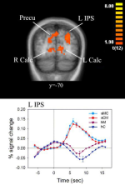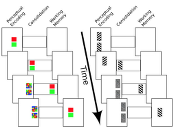This is a summary of several main themes of research in the lab. Please see the Publications page for more detailed information.
-
- Attentional modulation of sensory processing
 How does attention influences the processing of visual information? We use a combination of psychophysical, neuroimaging, and computational techniques to increase our understanding of the mechanisms by which attention selects sensory information. Several past and current research questions include the neural correlate of selective attention in early visual cortex for both bottom-up and top-down attention, spatio-temporal properties of feature-based attention, and the capacity of attentional modulation.
How does attention influences the processing of visual information? We use a combination of psychophysical, neuroimaging, and computational techniques to increase our understanding of the mechanisms by which attention selects sensory information. Several past and current research questions include the neural correlate of selective attention in early visual cortex for both bottom-up and top-down attention, spatio-temporal properties of feature-based attention, and the capacity of attentional modulation.
- Attentional modulation of sensory processing
-
- Attentional control
 While selective attention modulates neural processing in early visual cortex, it is also under the control of higher centers in the brain. Past work has established that the frontoparietal network plays a key role in controlling attention. We are particularly interested in the nature of attentional priority maintained in these areas. This work utilizes recent advances in multivariate fMRI analysis techniques by uncovering the information encoded in the distributed pattern of neural activity.
While selective attention modulates neural processing in early visual cortex, it is also under the control of higher centers in the brain. Past work has established that the frontoparietal network plays a key role in controlling attention. We are particularly interested in the nature of attentional priority maintained in these areas. This work utilizes recent advances in multivariate fMRI analysis techniques by uncovering the information encoded in the distributed pattern of neural activity.
- Attentional control
-
- Mechanisms of decision making
 How does the brain make decisions? A great deal of behavioral research has uncovered some commonalities during decision making, leading to the development of several important mathematical models of choice behavior. However, how such abstract models are instantiated in neural circuits is not clear. We have investigated the neural mechanisms of evidence accumulation during perceptual decision making, as well as the evidence accumulation process in preferential decisions. This work is done in collaboration with Tim Pleskac.
How does the brain make decisions? A great deal of behavioral research has uncovered some commonalities during decision making, leading to the development of several important mathematical models of choice behavior. However, how such abstract models are instantiated in neural circuits is not clear. We have investigated the neural mechanisms of evidence accumulation during perceptual decision making, as well as the evidence accumulation process in preferential decisions. This work is done in collaboration with Tim Pleskac.
- Mechanisms of decision making
-
- Visual working memory
 Working memory maintains and manipulates information in the short term and represents a crucial link between perception and decision. We have studied the initial formation of stable working memory representations (consolidation) as well as the nature of working memory storage. In particular, past work has focused on the bandwidth (or capacity) of consolidation and how it differs for different visual features. We are also interested in the neural basis of working memory consolidation and storage.
Working memory maintains and manipulates information in the short term and represents a crucial link between perception and decision. We have studied the initial formation of stable working memory representations (consolidation) as well as the nature of working memory storage. In particular, past work has focused on the bandwidth (or capacity) of consolidation and how it differs for different visual features. We are also interested in the neural basis of working memory consolidation and storage.
- Visual working memory
